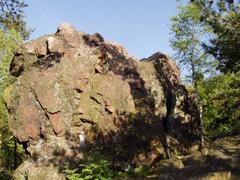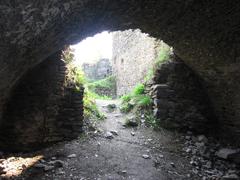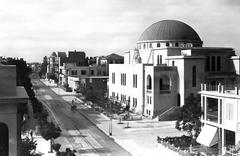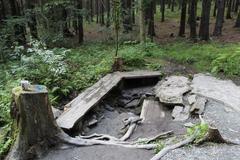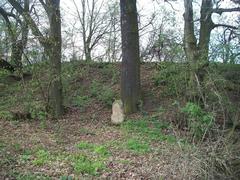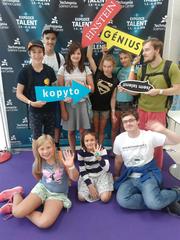Discover the Charms of Plzeň, Plzeň-City District, Czech Republic
Date: 13/08/2024
Start Your Plzeň Adventure with a Bang
Welcome to Plzeň, the enchanting city that brews more than just the world’s most famous beer. Nestled at the confluence of four rivers and adorned with a rich tapestry of history, architecture, and culture, Plzeň is a place where every cobblestone whispers tales of yore. Founded in the late 13th century, this city has evolved from a medieval fortress into a modern marvel, all while retaining its old-world charm (Visit Czechia). Imagine strolling through its streets, laid out in a high-Gothic chessboard pattern, with the spire of the Church of St. Bartholomew towering above, offering panoramic views that will leave you breathless.
But Plzeň is more than just a feast for the eyes. It’s a sensory delight—a place where the aroma of freshly brewed Pilsner beer mingles with the scent of blooming flowers in Lochotín Park. Here, the lively chatter of locals enjoying a sunny afternoon in one of the many parks creates a symphony that perfectly complements the city’s visual splendor. Whether you’re a history buff, an art aficionado, or a beer enthusiast, Plzeň has something to offer that will tickle your fancy—and your taste buds.
In this guide, we’ll take you on a journey through the ages, exploring Plzeň’s medieval origins, its Renaissance and Baroque flourishes, its industrial boom in the 19th century, and its resilient spirit in the modern era. We’ll uncover hidden gems, share insider tips, and even throw in some quirky customs and local lingo to help you blend in like a true Pilsner. So grab your map, lace up your walking shoes, and get ready to discover the secrets and stories of this captivating city. Your adventure in Plzeň starts now!
What’s Inside
- Discover Plzeň: A Journey Through Time and Taste
- From Medieval Beginnings to Modern Marvels
- Renaissance and Baroque Periods
- Industrial Revolution and the 19th Century
- 20th Century and Modern Developments
- Architectural Highlights
- Insider Tips and Hidden Gems
- Taste and Savor
- Engage and Explore
- Cultural Etiquette
- Practical Info with a Twist
- Pop Culture and Plzeň
- Time-Based Itineraries
- Local Lingo
- Seasonal Highlights
- Myth Busting and Surprises
- Storytime
- FAQ
Discover Plzeň: A Journey Through Time and Taste
From Medieval Beginnings to Modern Marvels
Welcome to Plzeň, a city that’s not just the birthplace of the world-famous Pilsner beer but also a treasure trove of history, culture, and hidden gems. Whether you’re a history buff, a beer enthusiast, or a curious traveler, Plzeň has something to offer that will tickle your fancy—and your taste buds!
Founding and Medieval Era: Where Four Rivers Meet
Imagine a city where four rivers come together to create a natural fortress. Plzeň, founded in the late 13th century, was strategically positioned at the confluence of the Úslava, Úhlava, Radbuza, and Mže rivers. Picture medieval streets laid out in a chessboard pattern, a hallmark of high-Gothic urban design. The Church of St. Bartholomew, with its towering spire reaching 103 meters, still dominates the skyline and offers a panoramic view that’s worth the climb.
Renaissance and Baroque Periods: A Flourish of Art and Architecture
Fast forward to the Renaissance period, and you’ll find Plzeň blossoming with architectural wonders. The Town Hall, a Renaissance masterpiece, stands as a testament to the city’s prosperity. Take a stroll and you’ll notice intricately crafted stone portals and citizens’ houses that whisper tales of a bygone era. The Baroque period added its own flair, with the bishopric building designed by Jakub Auguston being a prime example. These structures aren’t just buildings; they’re stories etched in stone.
Industrial Revolution and the 19th Century: Beer, Synagogues, and Parks
The 19th century was a game-changer for Plzeň, marking its rise as an industrial powerhouse. In 1842, the Pilsner Urquell Brewery was founded, revolutionizing the brewing industry with its gold standard Pilsner beer. Today, you can take a guided tour and sample this iconic brew straight from the source. But that’s not all—Plzeň is also home to the third largest synagogue in the world, a Moorish-Romanesque marvel that adds layers to the city’s rich cultural tapestry. Don’t forget to relax in the parks and orchards that replaced the old medieval fortifications, offering a green retreat in the heart of the city.
20th Century and Modern Developments: A Resilient City
The 20th century was a rollercoaster for Plzeň. During World War II, the city was a crucial industrial hub and was liberated by the U.S. Army in 1945—a moment celebrated annually with gusto. Post-war, Plzeň continued to build its industrial might. The 21st century brought a cultural renaissance, crowned by the city’s designation as the European Capital of Culture in 2015. Visit the Plzeň Historical Underground, a labyrinth of medieval cellars that’s now a hit with tourists.
Architectural Highlights: A Feast for the Eyes
Plzeň is an architectural smorgasbord. Here are some must-see sights:
- Church of St. Bartholomew: This Gothic gem with its sky-piercing spire is hard to miss.
- Town Hall: A Renaissance building that screams opulence and history.
- Great Synagogue: The third largest in the world, a Moorish-Romanesque wonder.
- Bishopric Building: A Baroque beauty by Jakub Auguston.
- Plzeň Historical Underground: Explore the maze of medieval cellars beneath your feet.
Insider Tips and Hidden Gems
- Local Secret: Visit the hidden gem of Lochotín Park, a serene spot often missed by tourists.
- Quirky Custom: Don’t be surprised if someone offers you a ‘Plzeňský hřeben’—a local slang for a shot of liquor to accompany your beer. Cheers!
- Hidden Gem: Check out the Techmania Science Center, a fun, interactive museum that’s great for families.
Taste and Savor: Sensory Delights
- Smell: The aroma of freshly brewed Pilsner beer wafting through the air.
- Taste: Indulge in traditional Czech cuisine at Restaurant U Salzmannů.
- Sound: The lively chatter of locals enjoying a sunny afternoon in one of Plzeň’s many parks.
- Sight: The stunning views from the top of St. Bartholomew’s tower.
- Touch: The cool, ancient stones of the historical underground cellars.
Engage and Explore: Interactive Fun
- Scavenger Hunt: Find the hidden ‘beer taps’ scattered around the city and snap a selfie with each.
- Photo Challenge: Capture the most unusual angle of the Great Synagogue and share it with the hashtag #PlzeňPics.
Cultural Etiquette: Blend in Like a Local
- Greeting: A simple “Ahoj” (hello) and a smile go a long way.
- Tipping: 10% is the norm, but rounding up the bill is also appreciated.
- Dining: When toasting, make eye contact and say “Na zdraví!” (Cheers!)
Practical Info with a Twist
- Accommodation: Luxury at Vienna House Easy by Wyndham or budget-friendly comfort at Hotel Ibis Plzeň? The choice is yours!
- Dining: Traditional vibes at Restaurant U Salzmannů or modern flair at DEPO2015 - Pilsen Creative Zone? Why not both?
- Transportation: Easy-peasy with public transport or enjoy a leisurely walk—Plzeň is delightfully compact.
Pop Culture and Plzeň
- Film Buffs: Remember that scene from ‘Kolja’? It was shot right here in Plzeň!
- Music Fans: The local band, Divokej Bill, often plays gigs in town. Catch one if you can!
Time-Based Itineraries: Choose Your Adventure
- Morning: Start with a tour of the Pilsner Urquell Brewery.
- Afternoon: Explore the Great Synagogue and grab lunch at a local café.
- Evening: Stroll through the historical underground cellars and finish with dinner at DEPO2015.
Local Lingo: Speak Like a Pilsner
- Pivo: Beer. Pronounced pee-voh. Use this word liberally.
- Děkuji: Thank you. Pronounced dyeh-koo-yee. Show your gratitude with flair.
- Prosím: Please/You’re welcome. Pronounced pro-seem. A versatile word to sprinkle into conversations.
Seasonal Highlights: Plzeň Through the Year
- Spring: The city blooms with flowers and festivals. Don’t miss the Pilsner Fest.
- Summer: Perfect for park picnics and outdoor concerts.
- Autumn: The foliage in Lochotín Park is Instagram-worthy.
- Winter: Cozy up with a hot drink at a Christmas market.
Myth Busting and Surprises
- Myth: Pilsner beer is just another lager. Fact: It’s the OG, the gold standard, the beer that started it all.
- Surprise: Did you know Plzeň has an underground labyrinth that dates back to the Middle Ages? Mind-blowing!
Storytime: Legends of Plzeň
- Legend: The tale of the Plzeň Dragon, said to have lived in the Radbuza River. Locals still tell stories of this mythical beast.
- Historical Anecdote: During WWII, Plzeň’s liberation by the U.S. Army was so momentous that it’s celebrated every year with parades and reenactments.
FAQ: Your Questions Answered
- When’s the best time to visit? Spring and autumn offer mild weather and fewer crowds.
- Is English widely spoken? Yes, especially in tourist areas.
- What’s the local currency? The Czech koruna (CZK).
Call to Action: Your Plzeň Adventure Awaits
Ready to dive into Plzeň’s rich tapestry of history, culture, and, of course, beer? Download the Audiala tour guide app for an enhanced experience packed with insider tips, interactive elements, and more. Your adventure in Plzeň starts now!
Historical Significance
Medieval Origins and Growth
Did you know that the world’s most famous beer, Pilsner, was born in a small Czech city with a history as frothy and rich as the drink itself? Plzeň, also known as Pilsen, was first mentioned as a castle in 976 during a battle between Duke Boleslaus II the Pious of Bohemia and Emperor Otto II (Wikipedia). The city was officially founded in 1295 by King Wenceslaus II, who granted it a civic charter as a “Royal City” and established a new town site approximately 10 kilometers from the original settlement, now known as Starý Plzenec. By the 14th century, Plzeň had become the third-largest city in Bohemia, following Prague and Kutná Hora, due to its strategic location on trade routes leading to Nuremberg and Regensburg (Britannica).
Hussite Wars and Catholic Resistance
During the 15th-century Hussite Wars, Plzeň emerged as a stronghold of Catholic resistance against the Hussites. The city was besieged three times by Prokop the Great but successfully withstood these sieges. Plzeň’s resistance was significant enough that it joined the league of Catholic nobles against King George of Poděbrady (Wikipedia). In 1468, the town acquired a printing press, and the first book published in Bohemia, the “Trojan Chronicle,” was printed here (Wikipedia).
Industrial Revolution and Škoda Works
The 19th century marked a period of rapid industrialization for Plzeň. The city became home to the Škoda Works, one of the most important engineering companies in Austria-Hungary and later in Czechoslovakia. The Škoda Works were known for manufacturing heavy machinery, military aircraft, railway locomotives, and cars. The company also pioneered the development of electric-railway locomotives with plastic body panels to reduce axle loadings (Britannica).
World War II and Post-War Era
During World War II, Plzeň’s strategic importance was underscored by the German occupation from 1939 to 1945. The Škoda Works were forced to produce armaments for the Wehrmacht, and the city housed a Gestapo prison and a forced labor camp in the Karlov district (Wikipedia). Following the war, the factories were rebuilt and restored to production, continuing their legacy in heavy industry (Britannica).
Communist Era and Uprising
The post-war communist era brought significant changes to Plzeň. After the 1948 Czechoslovak coup d’état, the government launched a currency reform in 1953, leading to widespread discontent and the Plzeň uprising. On June 1, 1953, over 20,000 people, mainly workers at the Škoda Works, protested against the government. The protest led to a severe government crackdown, including the destruction of the statue of Tomáš Garrigue Masaryk, which has since been re-erected (Wikipedia).
Cultural Significance
Pilsner Beer
Plzeň is globally renowned as the birthplace of Pilsner beer. In 1842, Bavarian brewer Josef Groll created the first batch of Pilsner beer at the Měšťanský pivovar (Citizen’s Brewery). This innovation led to the establishment of the Pilsner Urquell Brewery, which remains the largest brewery in the Czech Republic today (Wikipedia). Skip the crowded brewery tour and head to Na Parkánu, a hidden gem where locals swear by their unpasteurized Pilsner. The brewery offers tours that provide insights into the beer-making process and the history of this iconic beverage.
European Capital of Culture
In 2015, Plzeň was designated as the European Capital of Culture, highlighting its rich cultural heritage and vibrant arts scene. The city is known for its Baroque architecture, including landmarks such as St. Bartholomew’s Cathedral, the Renaissance town hall, and various burgher houses (Britannica). The designation brought numerous cultural events and festivals to the city, further enhancing its cultural significance.
Festivals and Events
Plzeň hosts a variety of festivals and events throughout the year. Notable events include the Liberation Festival in May, which commemorates the city’s liberation by the American army in 1945, and the Pilsner Fest in October, celebrating the city’s brewing heritage (Visit Pilsen). The BLIK BLIK Festival of Light in March showcases contemporary digital art, including laser mapping and interactive light expositions (Visit Pilsen).
Visitor Tips
Getting There
Getting to Plzeň is easier than brewing beer—just hop on a train from Prague and you’ll be there faster than you can say ‘Pilsner Urquell.’ Plzeň is conveniently located about 78 kilometers west of Prague, making it easily accessible by train or car. The recently renovated Main Railway Station offers modern amenities and a comfortable travel experience. Trains from Prague to Plzeň take approximately 75 minutes (Visit Pilsen).
Accommodation
Plzeň offers a range of accommodation options to suit different budgets and preferences. From luxury hotels to budget-friendly hostels, visitors can find suitable lodging within the city. Booking in advance is recommended, especially during major festivals and events.
Dining and Local Cuisine
Visitors to Plzeň can enjoy a variety of dining options, from traditional Czech cuisine to international fare. The city is known for its hearty dishes, such as svíčková (marinated beef with creamy sauce) and knedlíky (dumplings). For beer enthusiasts, a visit to the Pilsner Urquell Brewery’s restaurant is a must, offering traditional dishes paired with freshly brewed beer (Visit Pilsen).
Sightseeing and Activities
Feel the cobblestones under your feet, smell the hops in the air, hear the clinking of glasses, and taste the crisp Pilsner that makes this city famous. Plzeň offers numerous attractions for visitors to explore. Key sights include St. Bartholomew’s Cathedral, the Great Synagogue, and the Brewery Museum. The DEPO2015 creativity zone hosts various cultural events and exhibitions, making it a vibrant hub for art and innovation (Visit Pilsen).
Shopping
For those interested in shopping, Plzeň has a variety of stores and markets offering everything from local crafts to international brands. The city center is home to numerous boutiques and shops, while larger shopping centers can be found on the outskirts of the city.
Safety and Practical Information
Plzeň is generally a safe city for tourists, but it is always advisable to take standard precautions, such as keeping an eye on personal belongings and avoiding poorly lit areas at night. The local currency is the Czech koruna (CZK), and credit cards are widely accepted. English is commonly spoken in tourist areas, but learning a few basic Czech phrases can enhance the travel experience.
When in Plzeň, always clink glasses and make eye contact before taking a sip—it’s bad luck otherwise! By understanding the historical and cultural significance of Plzeň, along with practical visitor tips, tourists can fully appreciate and enjoy their time in this remarkable city. Ready to uncover Plzeň’s secrets? Download Audiala, the ultimate audio guide app, and let expert insights and hidden gems enhance your journey.
Discover Plzeň: The Hidden Gem of the Czech Republic
Getting There
By Air: The nearest international airport to Plzeň is Václav Havel Airport Prague (PRG), located approximately 90 kilometers away. From the airport, you can zip to Plzeň via taxi, shuttle bus, or public transportation. For flight details, visit Václav Havel Airport Prague.
By Train: Plzeň’s railway network is your gateway from various European cities. Hop on direct trains from Prague, Munich, or Nuremberg. The main station is Pilsen Main Station (Praha hlavni nadrazi). For schedules and tickets, check Czech Railways.
By Car: Fancy a road trip? Drive to Plzeň via the D5 motorway, linking Prague and the German border. Car rentals are available at the airport and major cities. For rental options, visit Discover Cars.
Accommodation
Plzeň offers a mix of charming stays to fit any budget. Here are some top picks:
City Center: Stay close to Republic Square and the Pilsner Urquell Brewery. Try Hotel Central or Rous Hotel.
Slovany: East of the center, Slovany boasts beautiful parks like Lochotin Park. Check out Hotel Victoria.
Skvrňany: North of the city center, this peaceful residential area is perfect for a quiet stay. Consider Hotel Panorama.
Local Transportation
Public Transport: Plzeň’s public transportation includes trams, buses, and trolleybuses. Tickets are available at kiosks, machines, or via mobile apps. For details, visit Plzeň Public Transport.
Biking: Enjoy Plzeň’s bike-friendly paths. Rent a bike and explore at your own pace. For rentals, visit Kola Plzeň.
Walking: The pedestrian-friendly center is perfect for a stroll. Enjoy the parks and historic streets.
Dining and Local Cuisine
Plzeň’s culinary scene is as diverse as it is delicious. Here are some must-try spots:
Traditional Czech Cuisine: Savor authentic dishes at Restaurant U Salzmannů or Restaurant Švejk - U pětatřicátníků.
Modern Cuisine: Experience a twist on classics at Lékárna Restaurant or U Mansfelda Restaurant.
International Cuisine: For variety, explore the city’s Italian, Asian, and American eateries. Find more options at Visit Plzeň.
Must-See Attractions
Pilsner Urquell Brewery: Don’t miss a tour of the birthplace of Pilsner beer. Enjoy tastings and learn about brewing at Pilsner Urquell Brewery.
Republic Square: One of Europe’s largest squares, surrounded by pastel townhouses and landmarks like the Gothic Cathedral of St. Bartholomew. More at Visit Plzeň.
Historical Underground: Explore 14th-century tunnels, cellars, and wells. For tours, visit Plzeň Historical Underground.
Great Synagogue: This Moorish-style synagogue, built in 1892, is among the world’s largest. Learn more at Great Synagogue.
Techmania Science Centre: Perfect for families, with interactive exhibits and a 3D planetarium. More at Techmania Science Centre.
Cultural Insights
Festivals and Events: Enjoy annual celebrations like Pilsner Fest and the International Film Festival in Karlovy Vary. For event details, visit Visit Plzeň.
Art and Museums: Visit the Museum of West Bohemia, the Gallery of West Bohemia, and the Puppet Museum. More at Plzeň Museums.
Local Markets: Discover fresh produce, crafts, and local delicacies at Plzeň’s farmers’ markets. For schedules, visit Plzeň Farmers’ Markets.
Practical Tips
Language: Czech is the official language, but English is common in tourist areas. Learning some basic phrases can be fun and helpful.
Currency: The Czech koruna (CZK) is the currency. Credit cards are widely accepted, but it’s good to have cash for small purchases.
Weather: Plzeň has a temperate climate with warm summers and cold winters. The best time to visit is May to September. For current weather, visit Weather.com.
Safety: Plzeň is generally safe, but stay aware of your belongings, especially in crowded areas.
Emergency Numbers: Dial 112 for general emergencies, 150 for fire, 155 for medical assistance, and 158 for police.
By following these tips, you’ll enjoy a memorable experience in charming Plzeň. For more details and planning, visit Visit Plzeň.
Your Next Steps in Plzeň
As your journey through Plzeň comes to an end, it’s clear that this city is much more than the sum of its historical landmarks and world-famous beer. Plzeň is a living, breathing tapestry of culture, history, and innovation, where each era has left its unique mark. From the medieval streets that echo with tales of knights and fortresses to the Renaissance masterpieces that whisper of a prosperous past, and from the industrial might of the 19th century to the resilient spirit of the modern era, Plzeň stands as a testament to the enduring human spirit.
But it’s not just the landmarks and historical sites that make Plzeň special—it’s the vibrant culture, the welcoming locals, and the sensory experiences that make every visit unforgettable. Whether you’re sampling a freshly brewed Pilsner at the Pilsner Urquell Brewery, exploring the labyrinthine historical underground, or simply enjoying a leisurely stroll through one of the city’s many parks, Plzeň offers a plethora of experiences that engage all your senses.
And let’s not forget the hidden gems and insider tips that make Plzeň truly unique. From the serene beauty of Lochotín Park to the interactive fun at the Techmania Science Center, there’s always something new to discover. So why not make your next adventure a trip to Plzeň? Download the Audiala tour guide app to unlock even more secrets and stories, and let expert insights and hidden gems enhance your journey. Your adventure in Plzeň awaits—na zdraví! (Visit Czechia, Wikipedia, Visit Pilsen).
Sources and Inspirations
- Visit Czechia, 2024, Visit Czech Republic Visit Czechia
- Wikipedia, 2024, Wikipedia Wikipedia
- Visit Pilsen, 2024, Visit Pilsen Visit Pilsen

